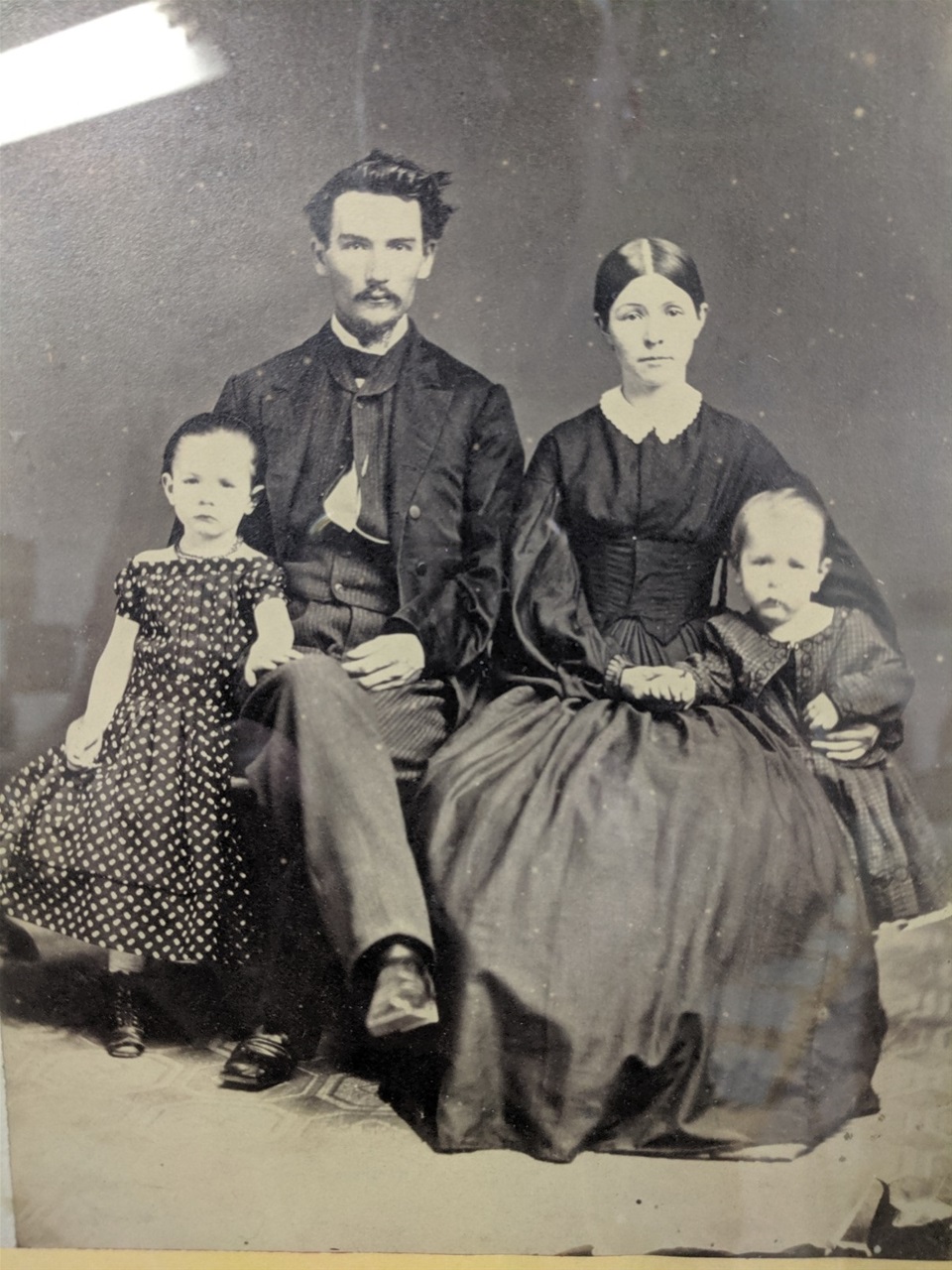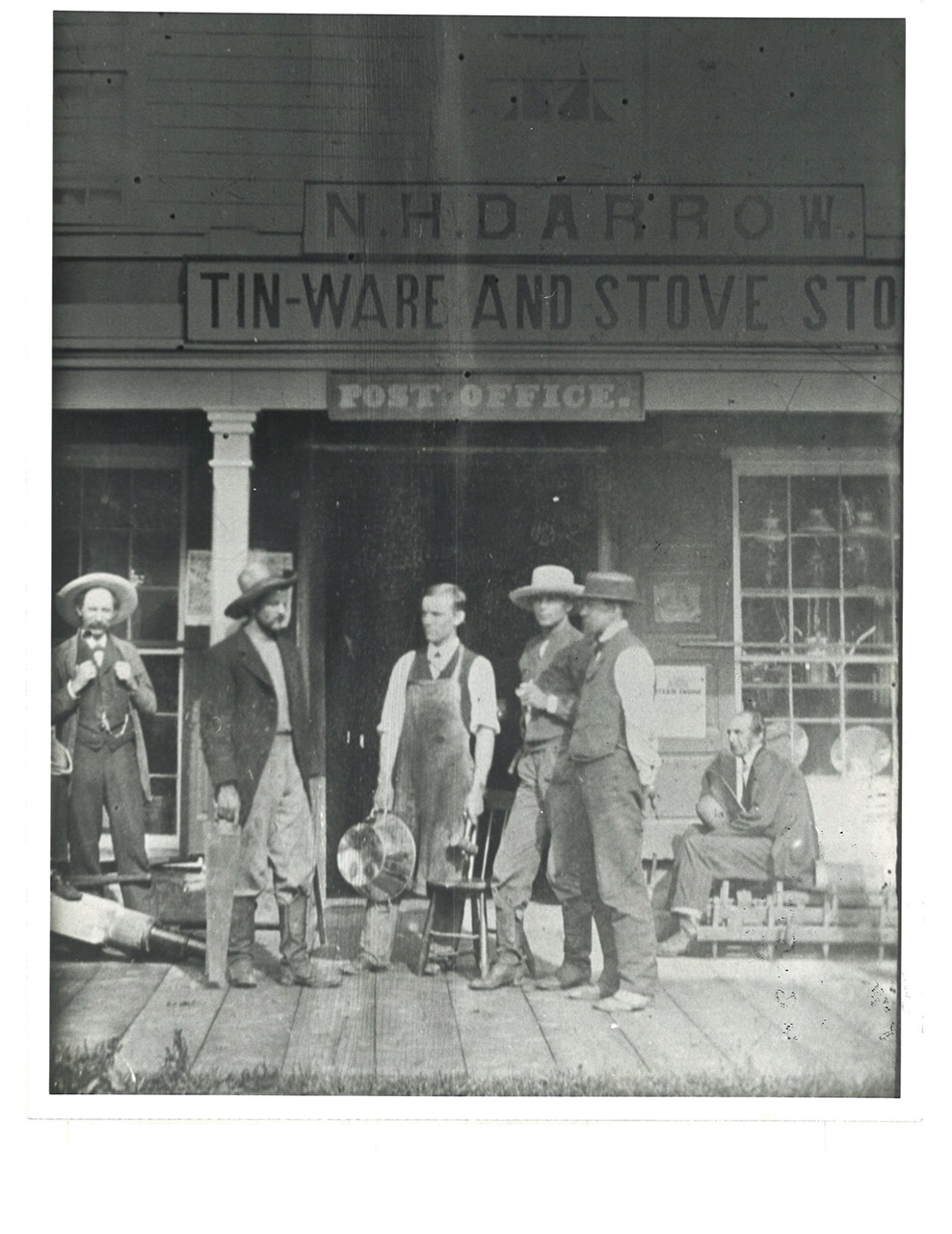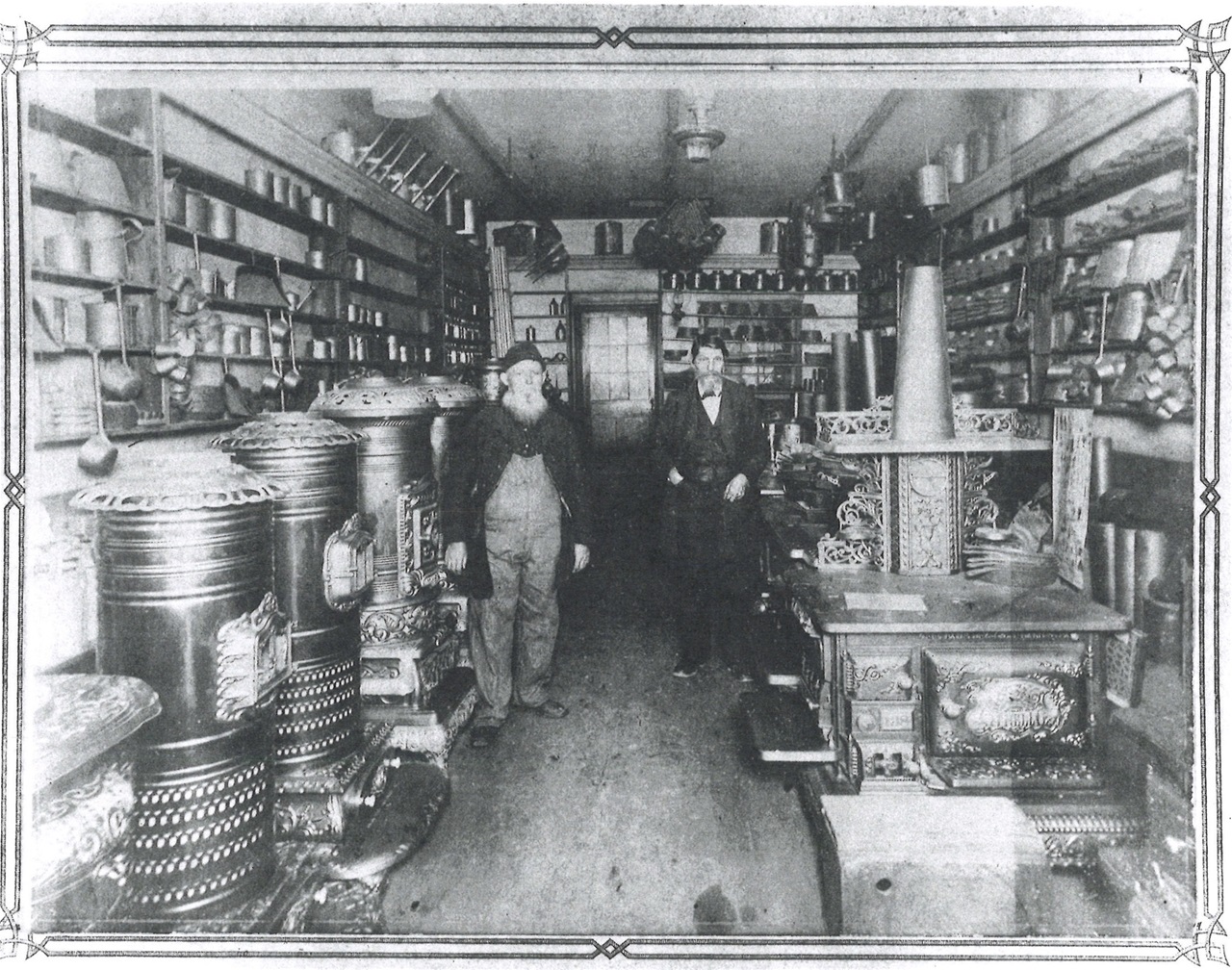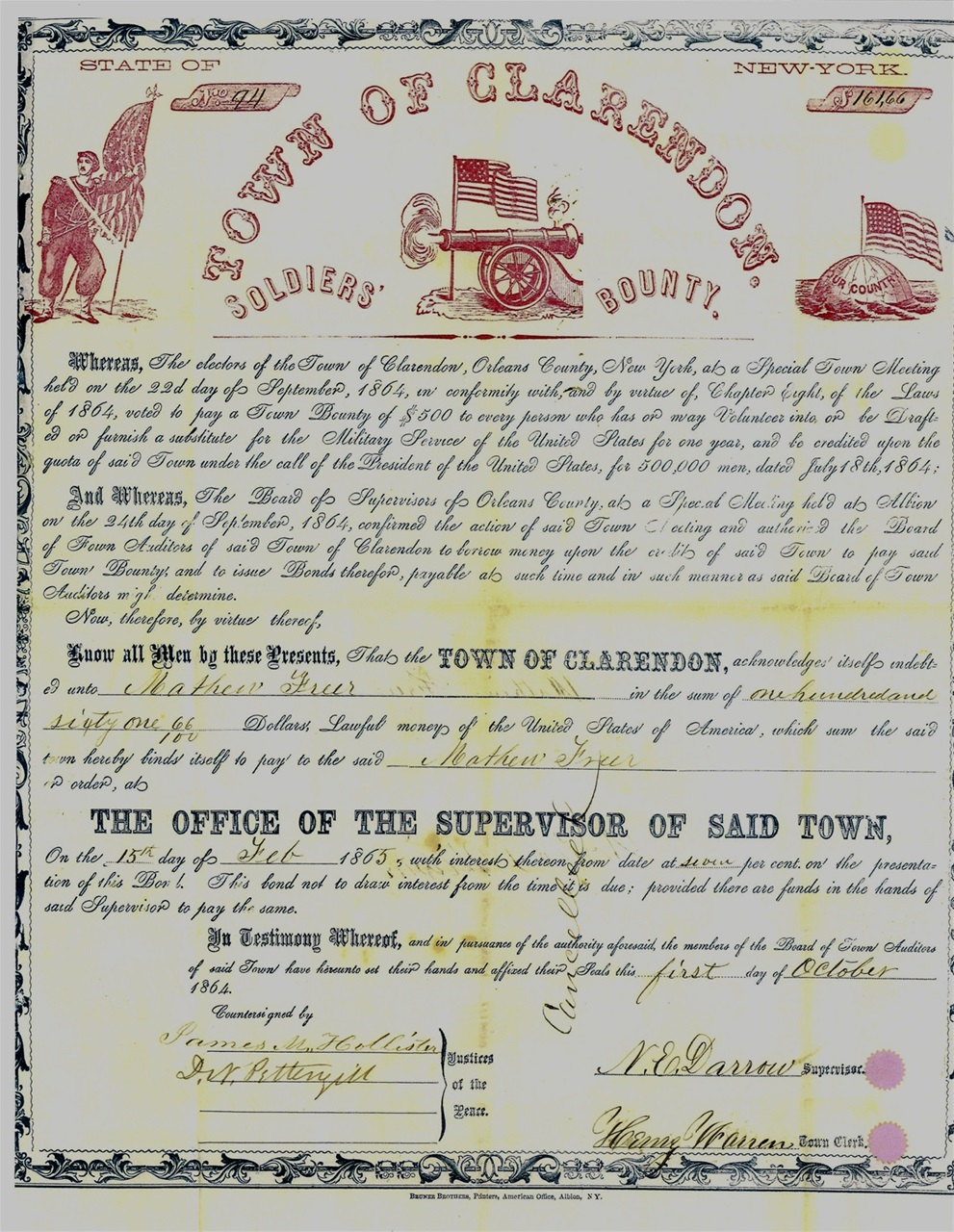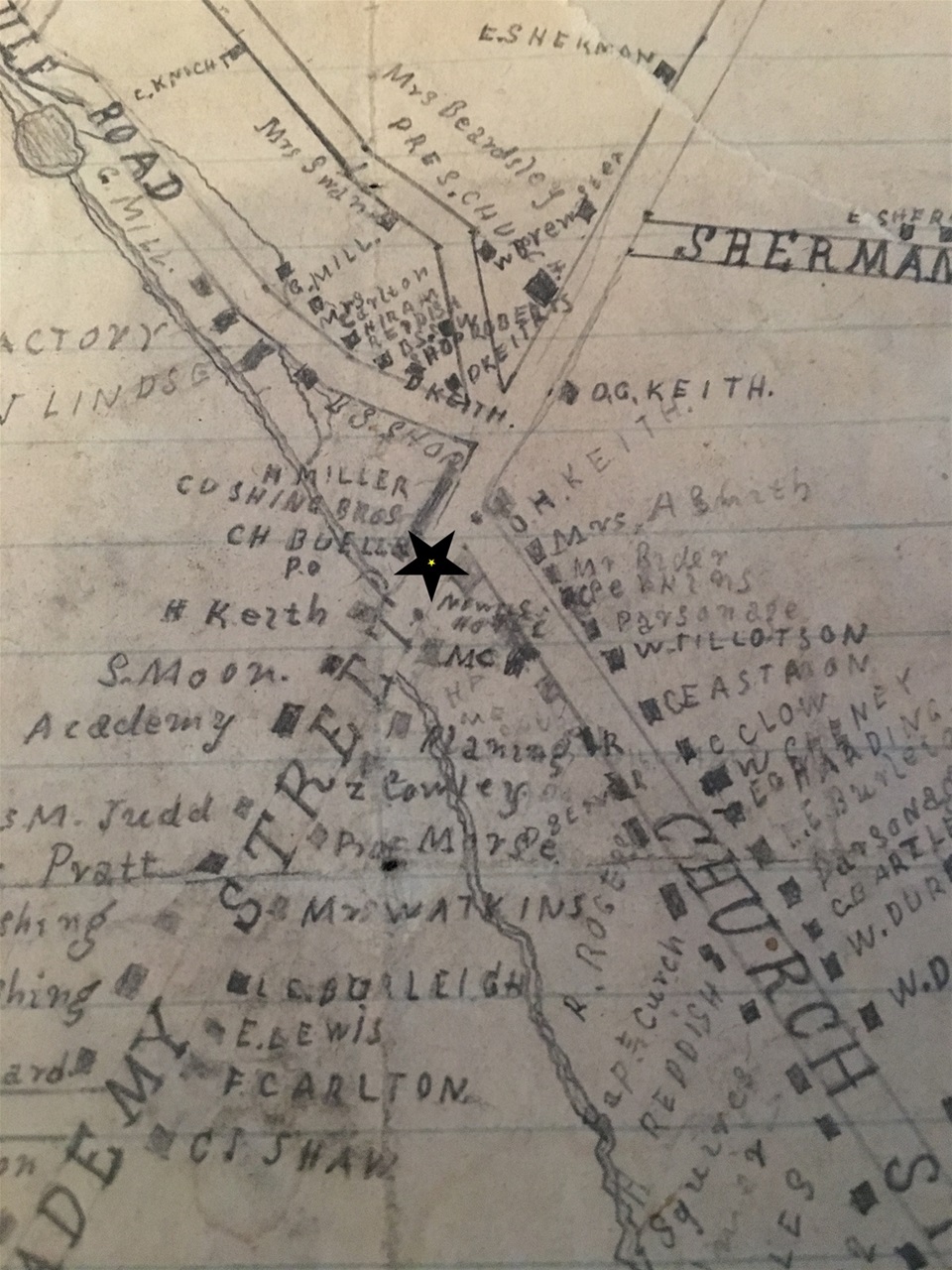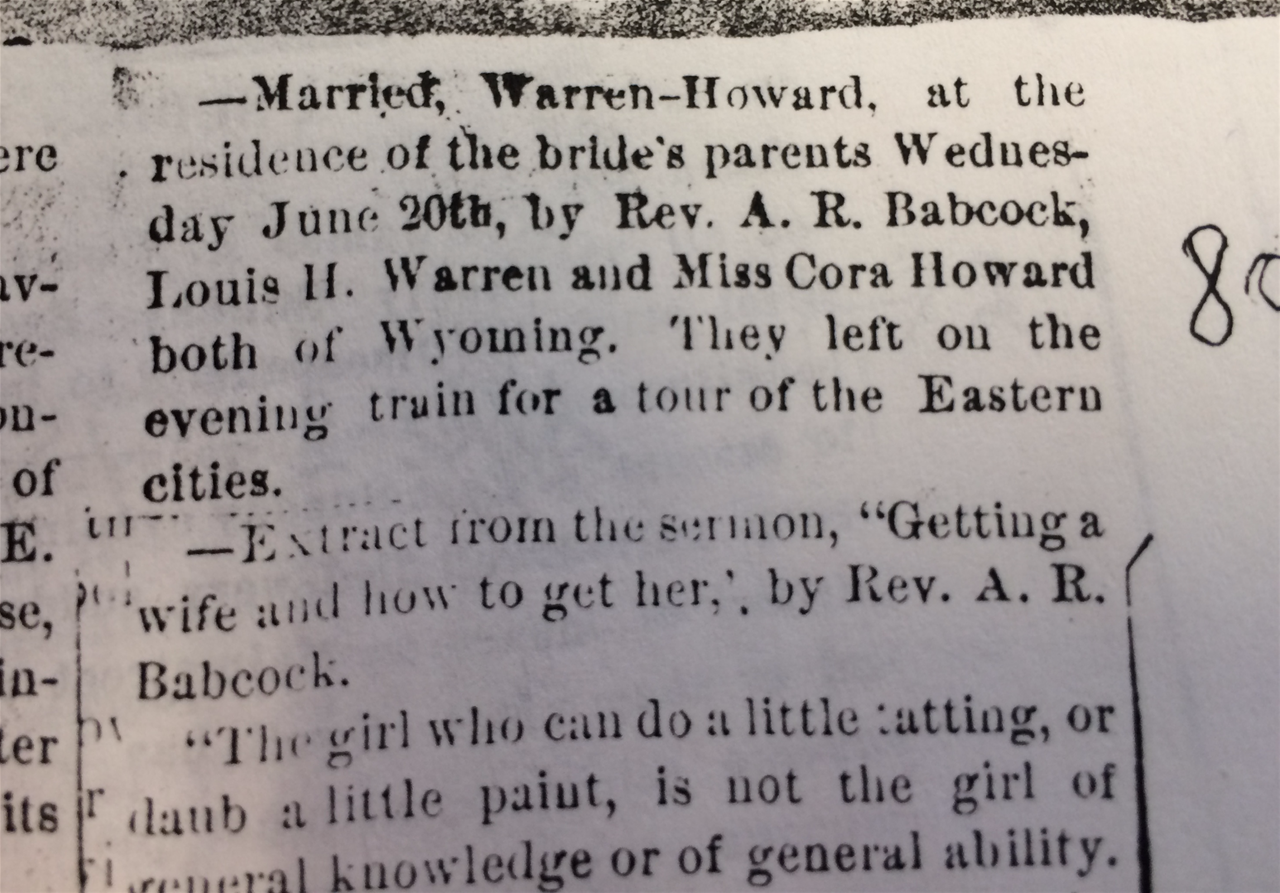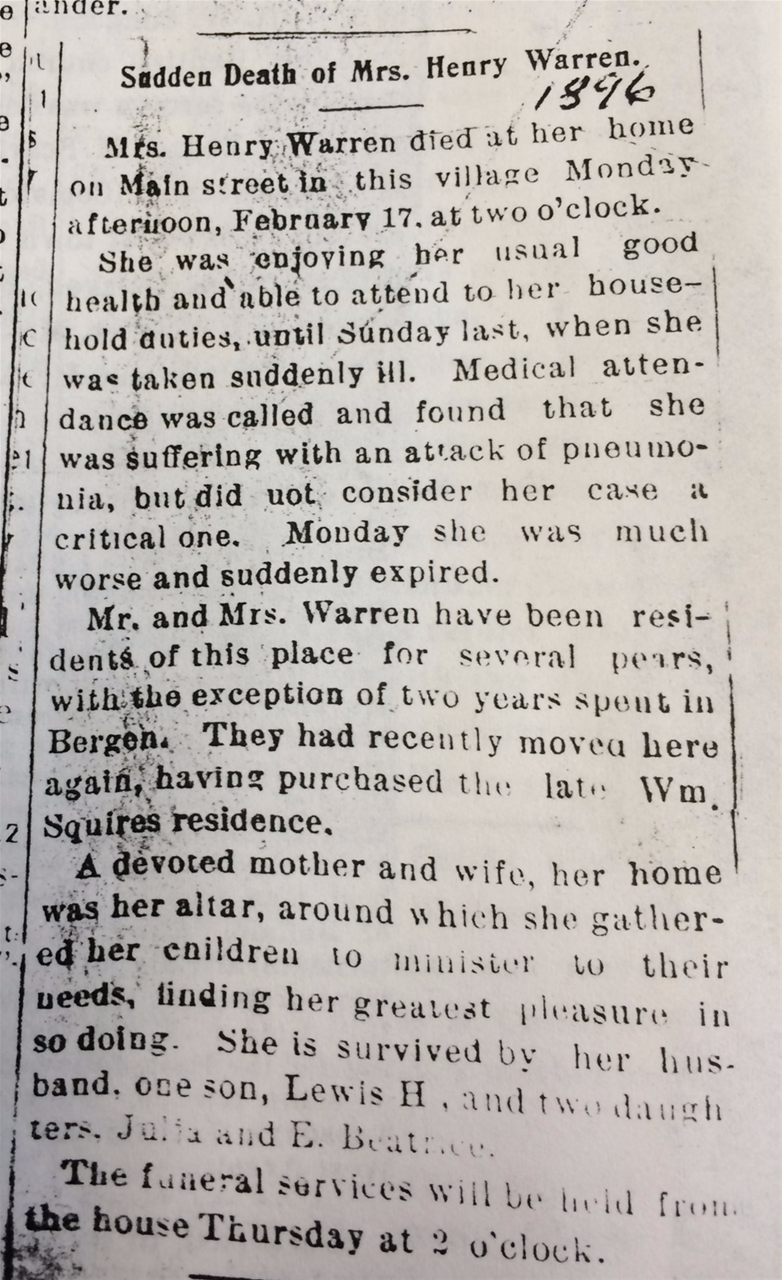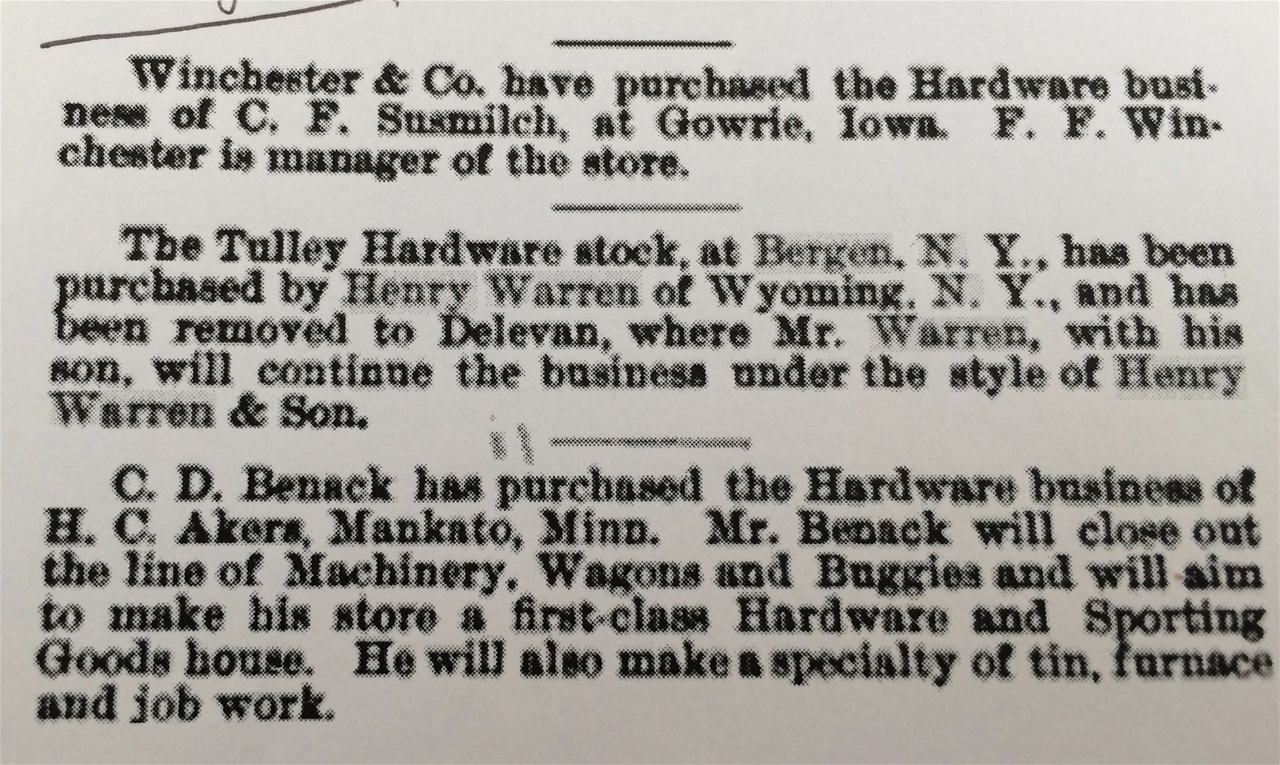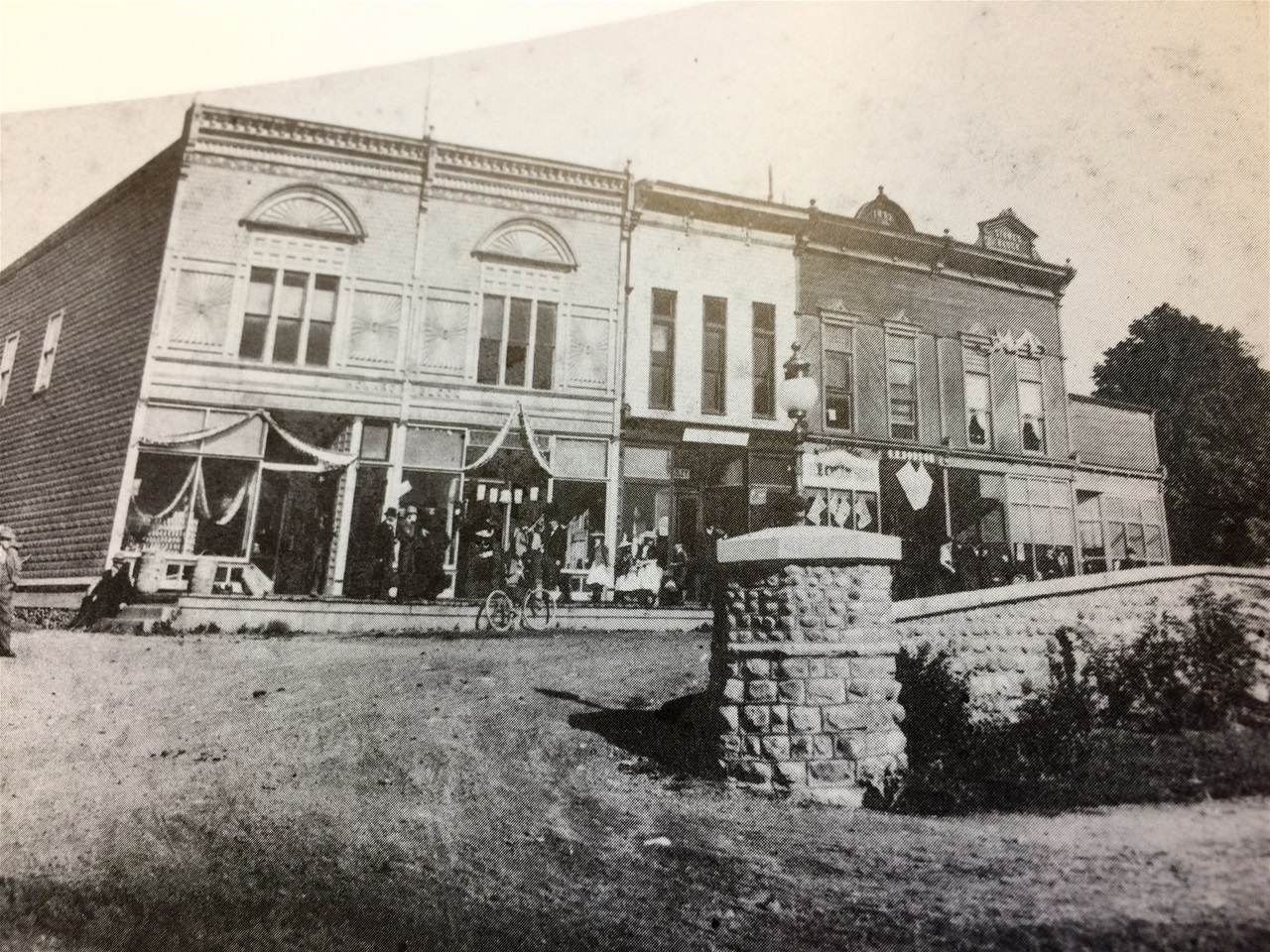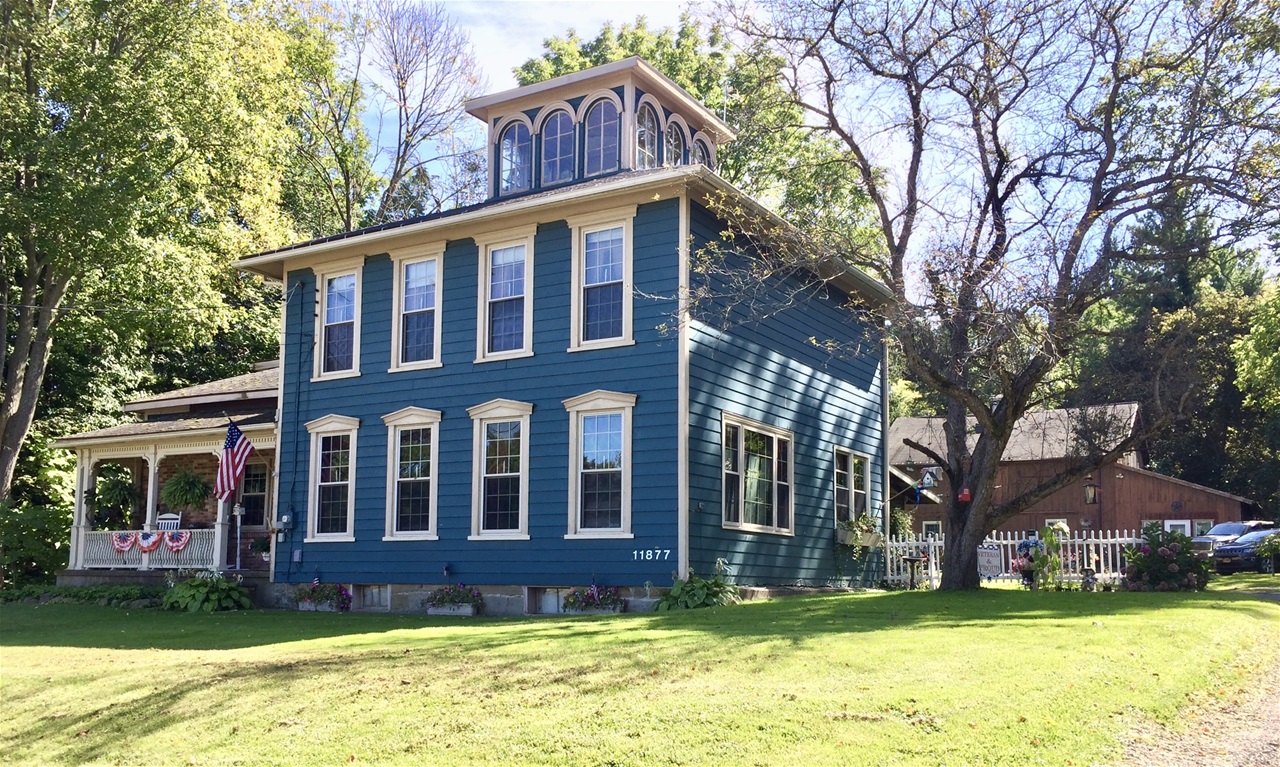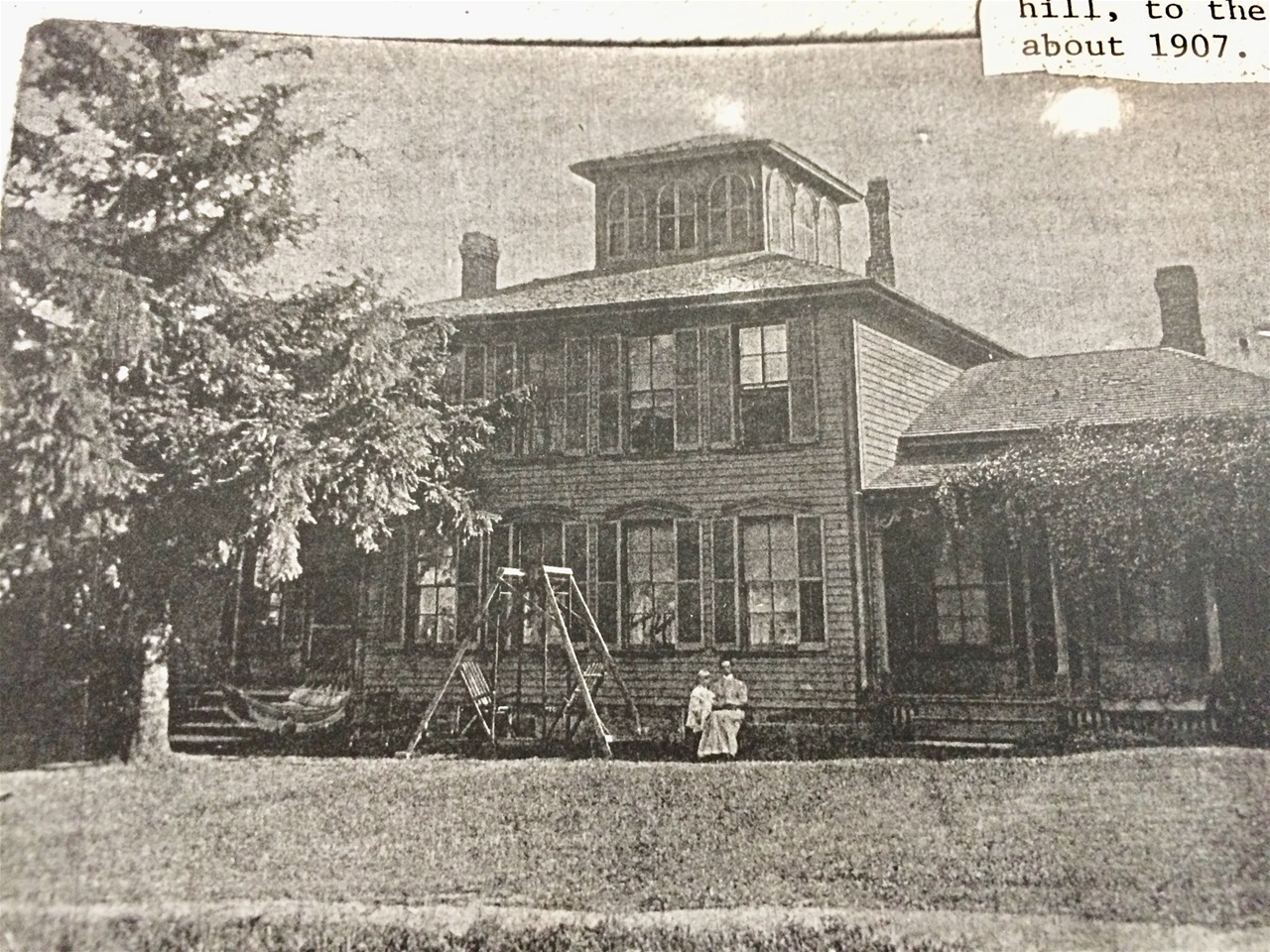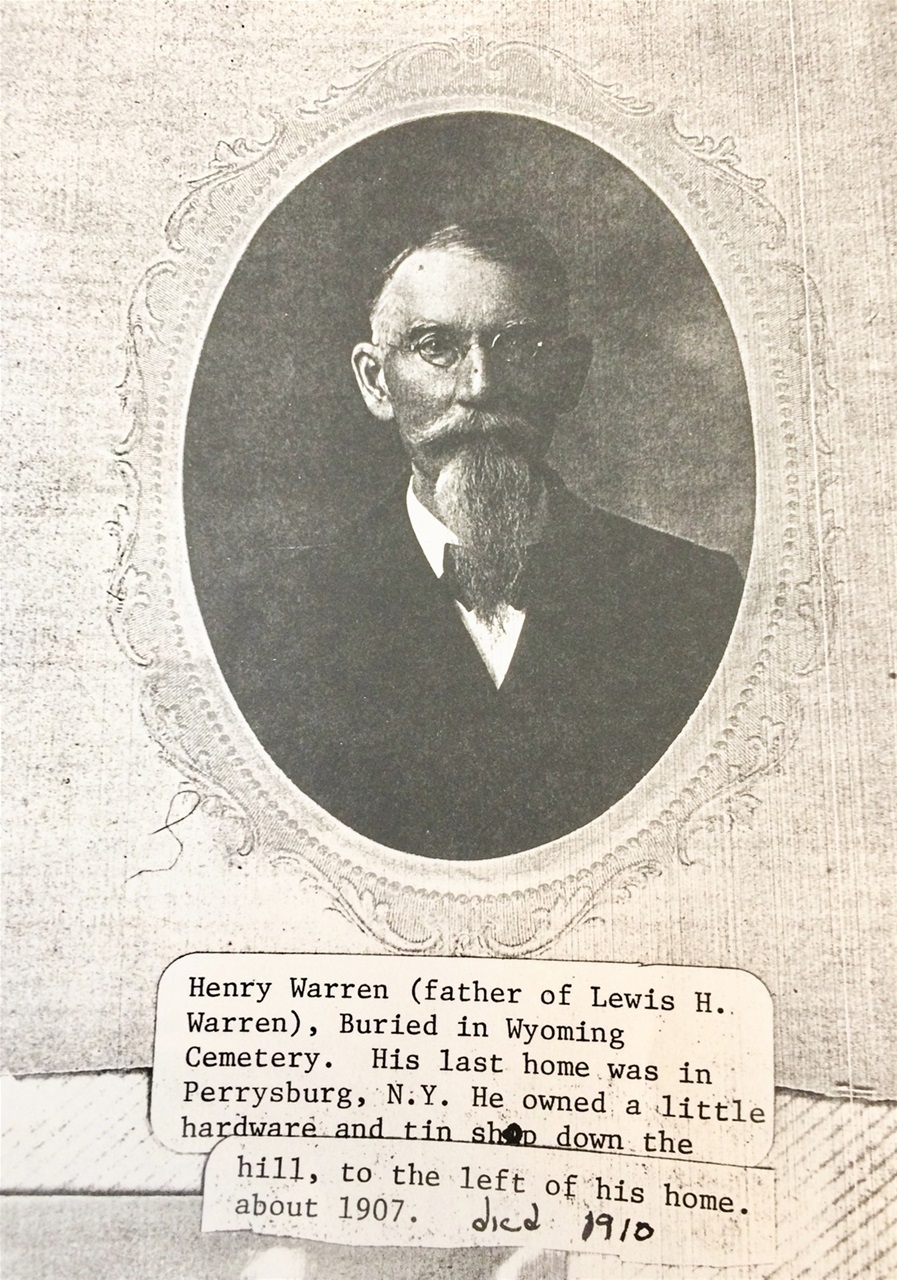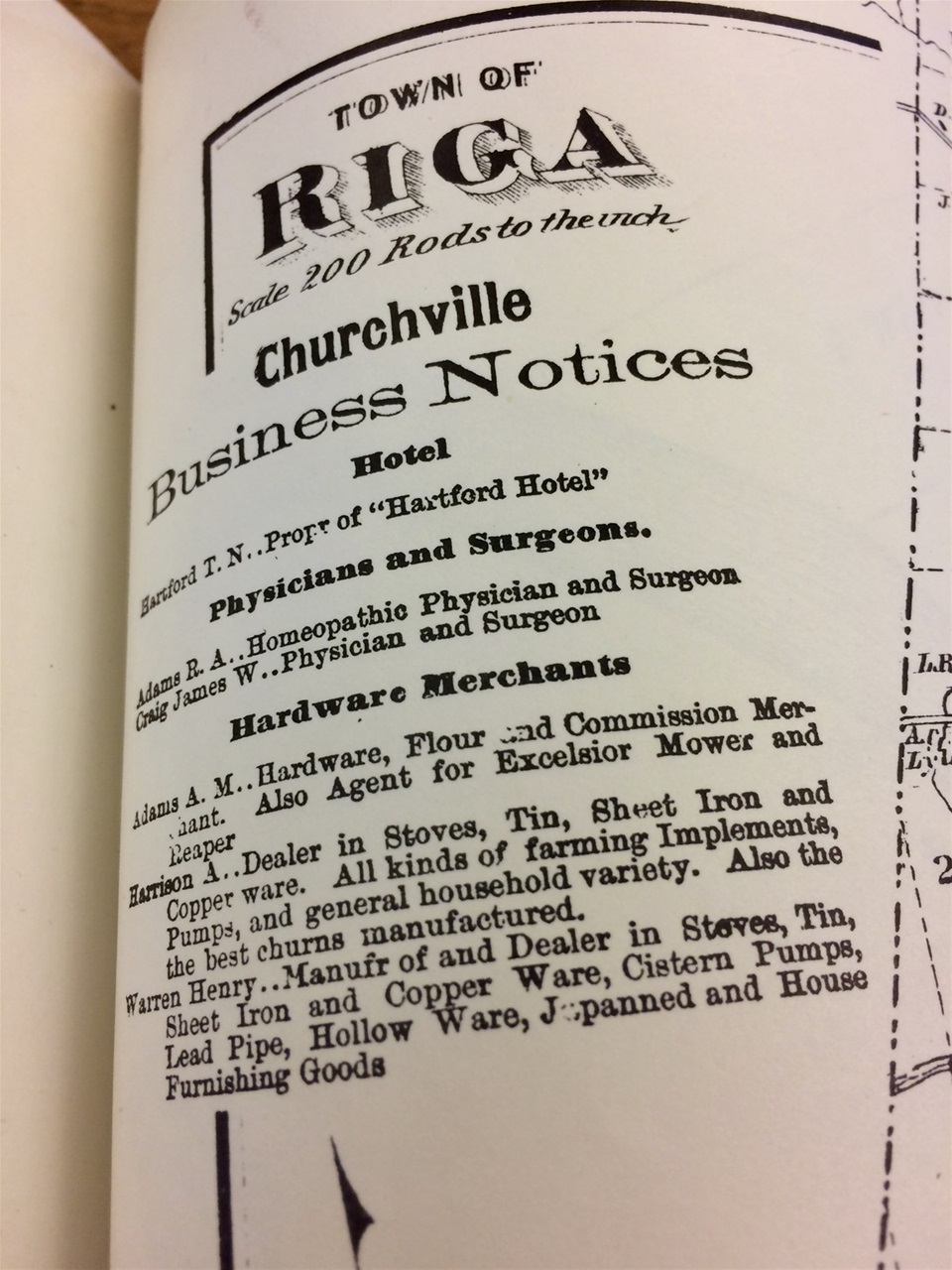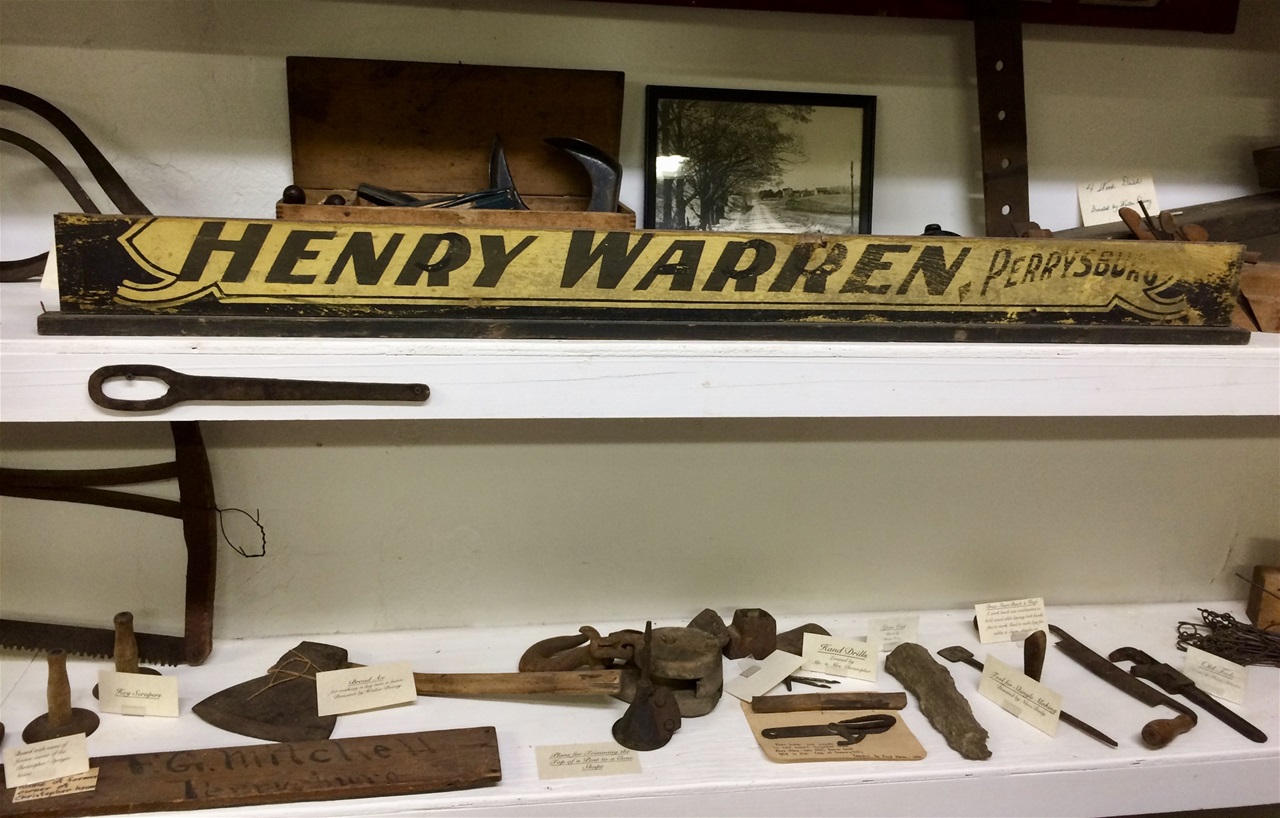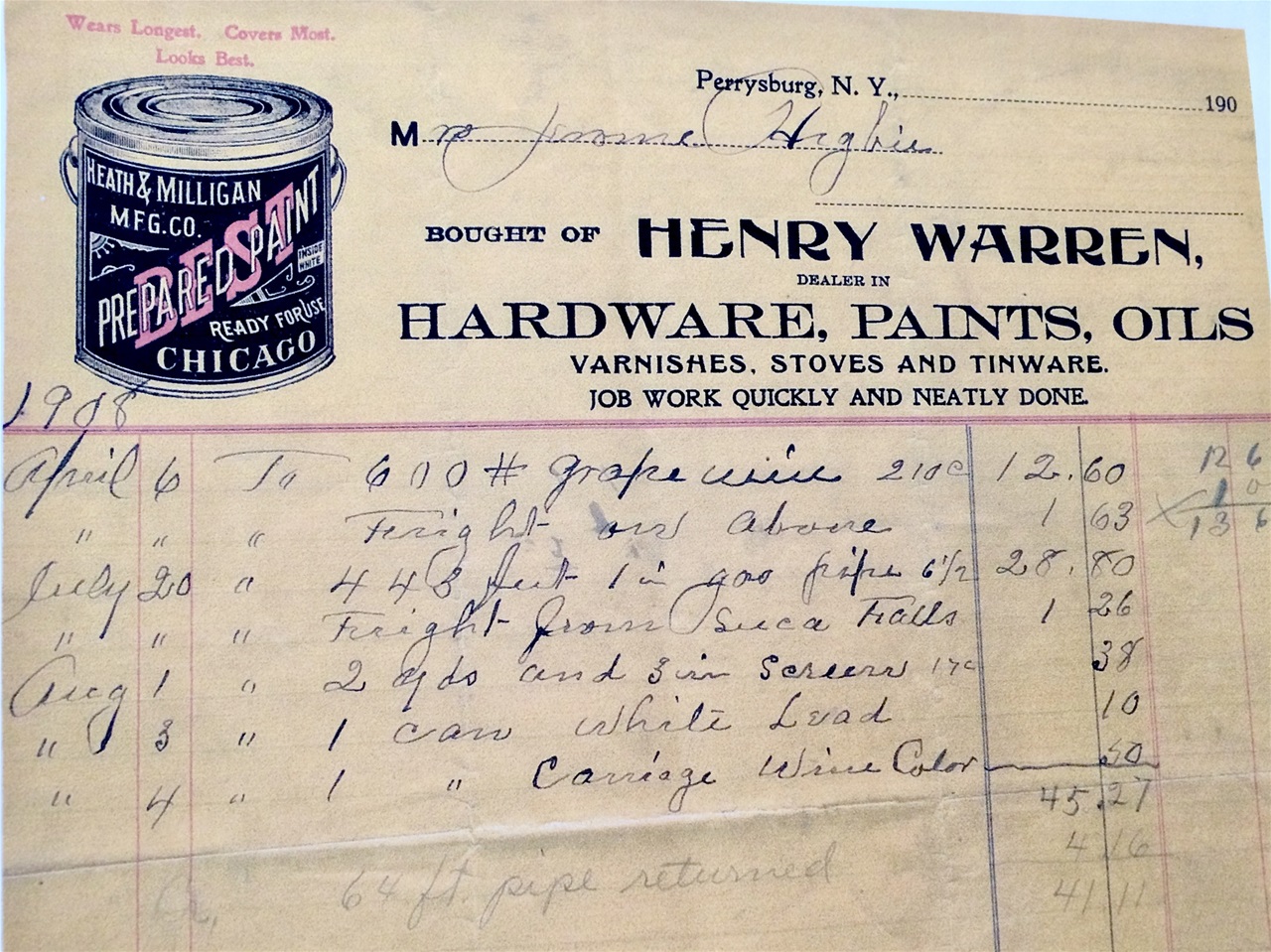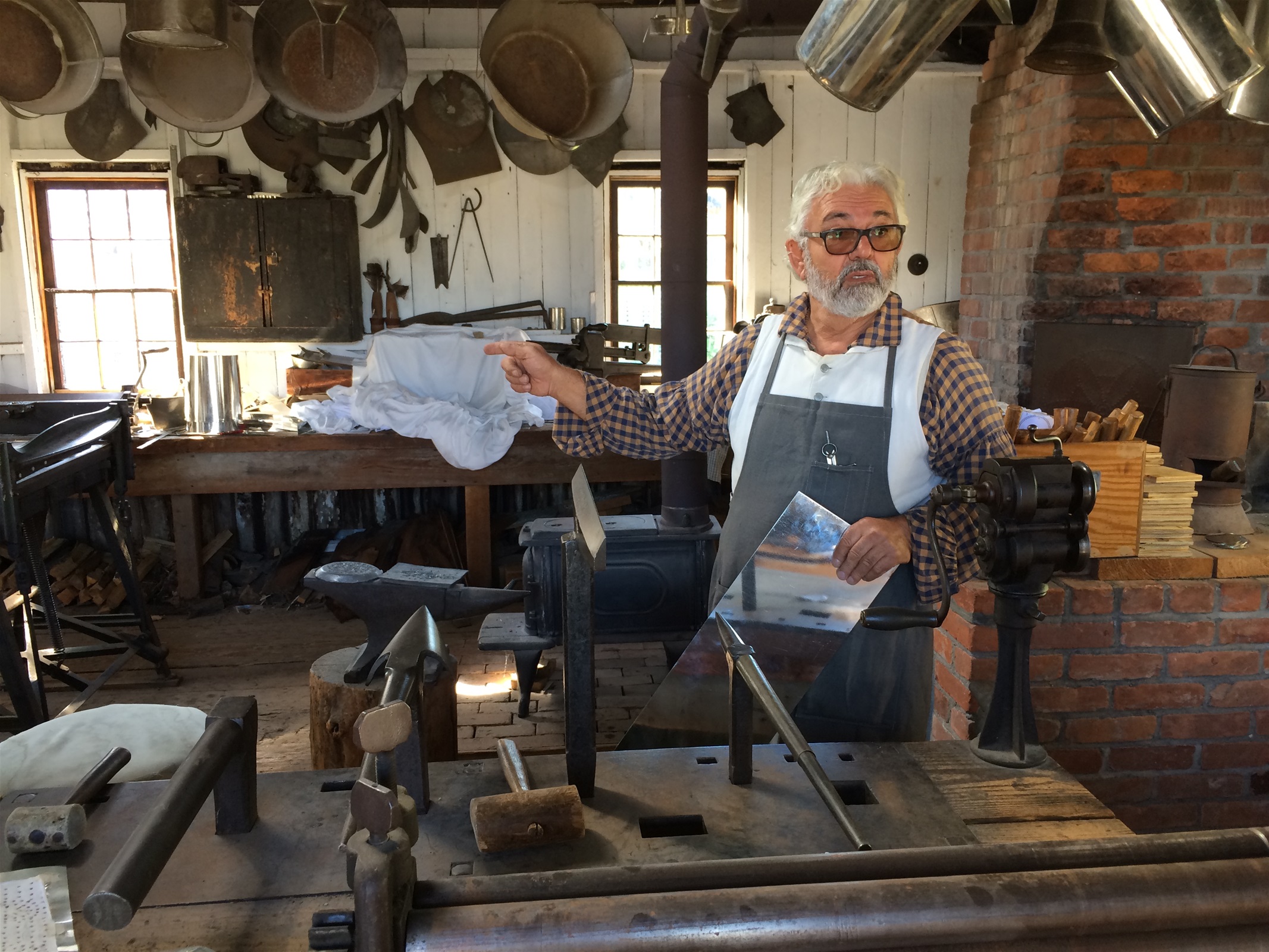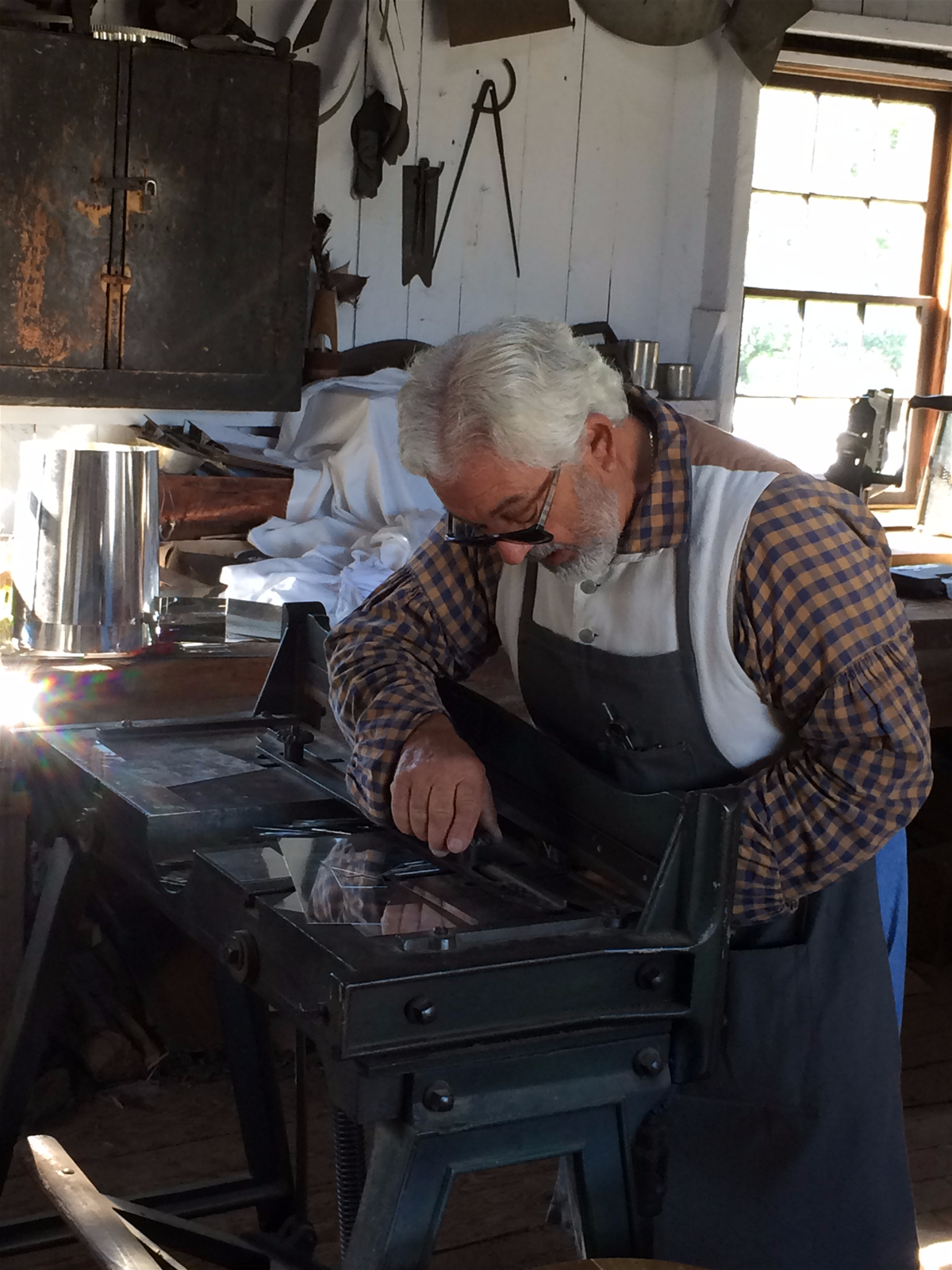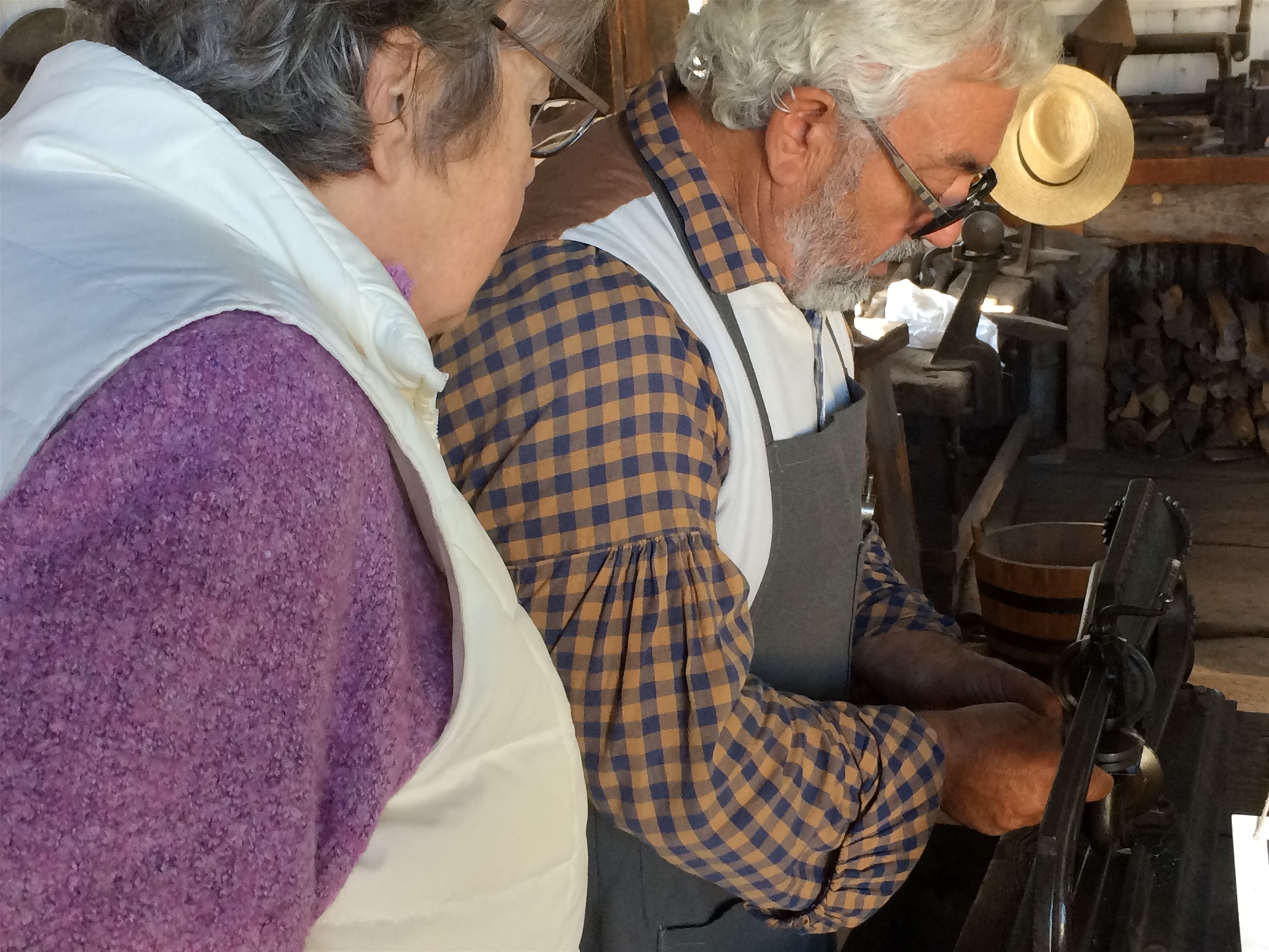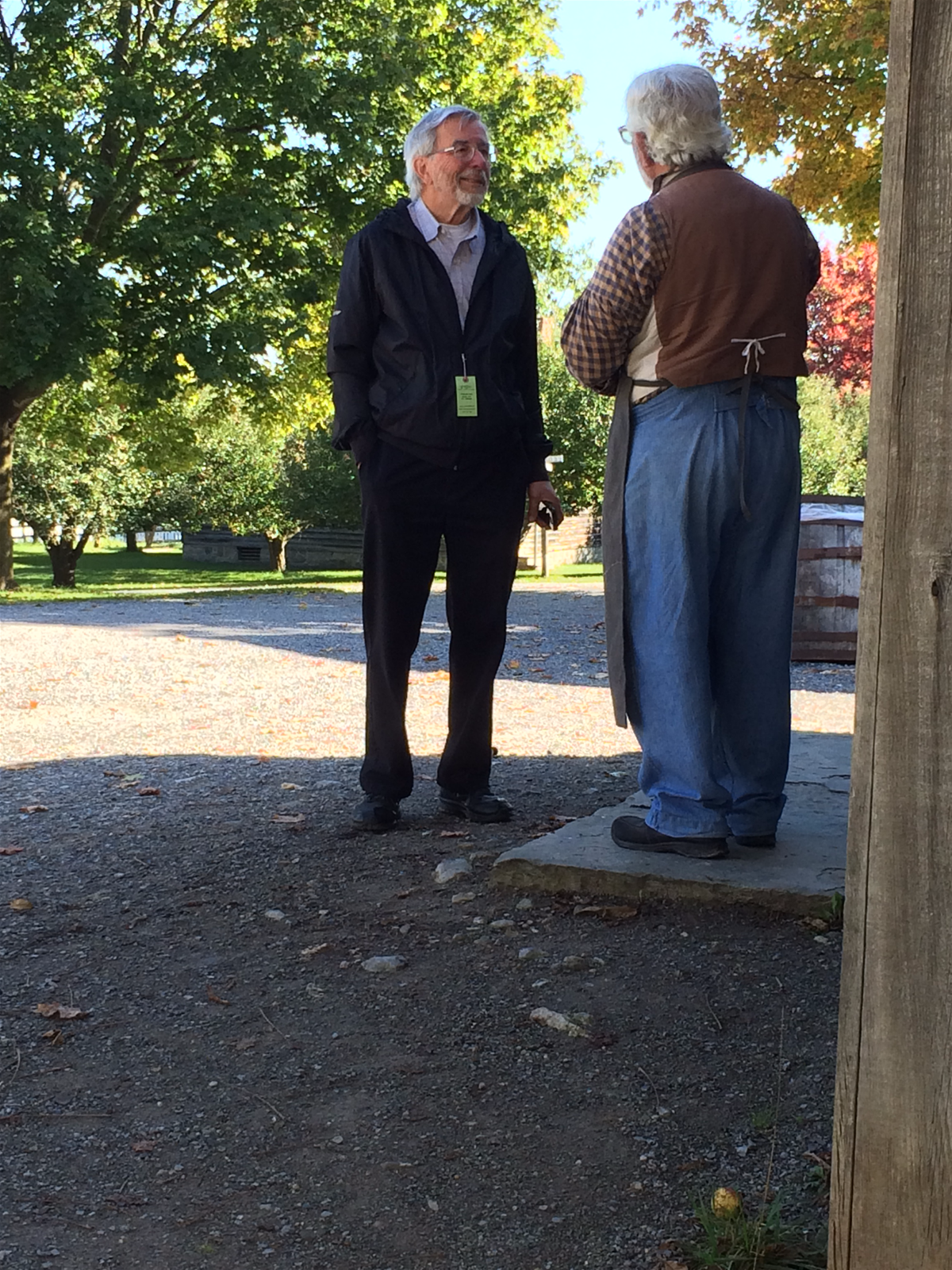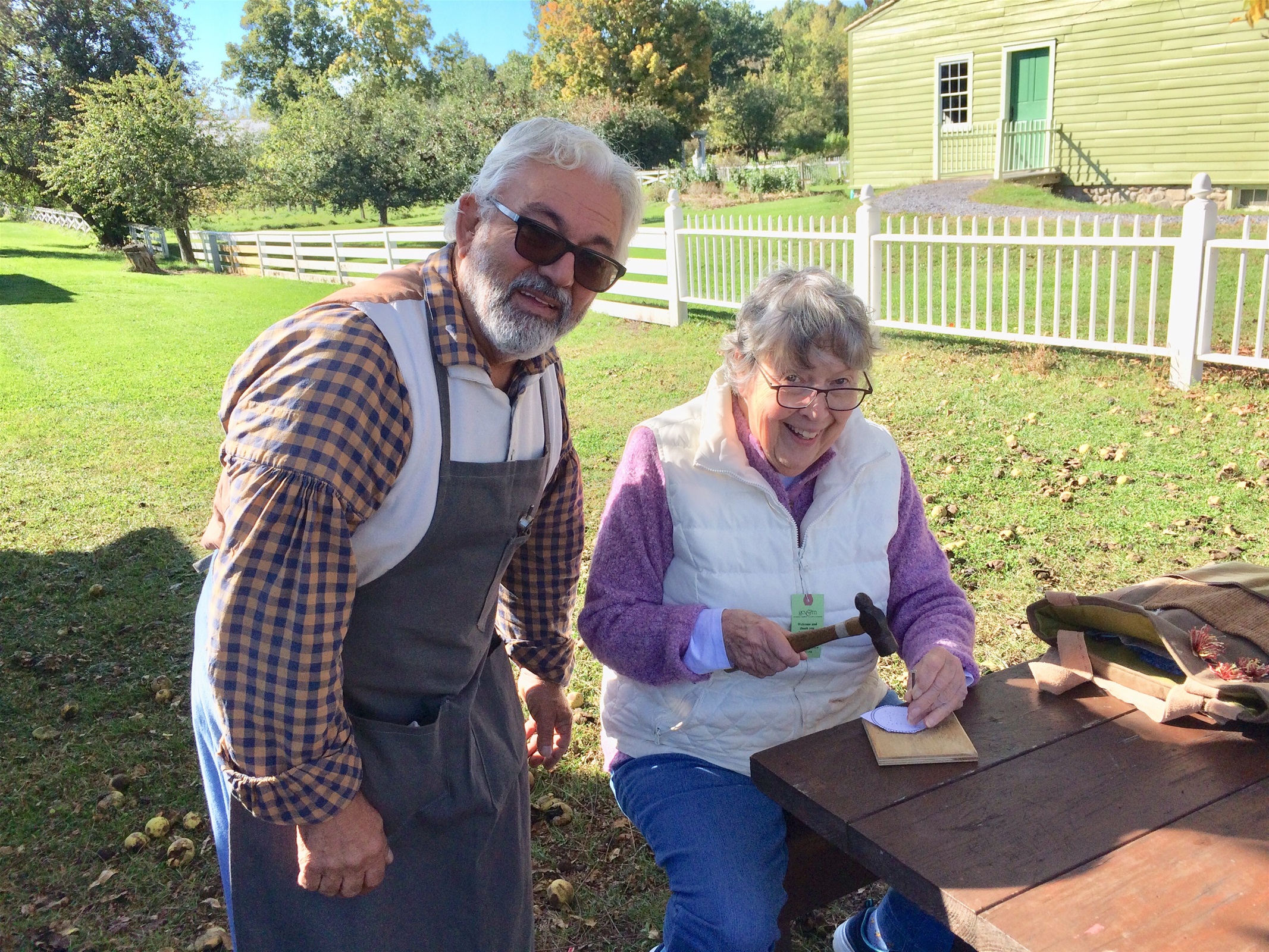This time, in "Tales of Yore.....Family" we are going to switch sides-- from stories about the Bailey family, my mother Rhoda Bailey Warren's family, to my father's side of the family, the Warrens. The former Bailey blogs are still up there under Previous Posts above if you'd like to look back. But now.....
Meet the Henry Warren family!
As our great-grandfather Henry Warren looks at us intensely from this picture of about 1865, I must comment that I immediately see where I got this uncontrollable cowlick that makes my hair stand up at the back of my head. Great-grandmother Emma, on the other hand, looks tentatively at the camera. We know very little about her life until the end. Then, when she died at age 59 at their home on Main St in Wyoming village in 1896, her obituary described her this way:
"A devoted mother and wife, her home was her altar around which she gathered her children to minister to their needs, finding her greatest pleasure in so doing."
As I've read about this family, admittedly through the mist of over 150 years, Henry didn't always make it easy for her, and life had at least the usual share of ups and downs ahead. Those words for her seem well-chosen.
But just for today, in our picture we see a young family, a very focused 28 year-old Henry pushing his way towards a prosperous future for the family and a quiet Emma taking care of their home and children. They pose with their two oldest children (daughters Minnie and Emma were born later), little Julia with her hand resting trustingly on her papa, and Emma's arm protectively around Lewis Henry. This picture is very touching to me--it's this little Lewis who became our grandfather.
Henry Warren's family came to western New York state, to Orleans County, as part of a wave of migration from Vermont in the 1830's. His grandfather Aaron Warren fought in the Revolutionary War and then returned to Murray, NY, where he owned a grain mill. His father became a farmer in nearby Clarendon.
Henry chooses a new path
This intense Henry had other ideas for himself. After working some years as a "tinner" in Clarendon, in 1863, at the age of 26 with two small children at home, Henry started his own tin shop. This photo is from a tiny tintype in the town museum. The men are not named, but the short span of tintype use (pretty limited to the 1860's), the topic (showing off tinware and tools), the strong resemblance of the man on the left by the pillar to Henry Warren in the picture above and the fact that they are standing outside the store Henry purchased, all make me want to believe this photo may have been an announcement of the opening of Henry Warren's new tin shop. Melissa Ierlan, Clarendon town historian, very kindly helped me find the purchase information for Henry's store in 1863. Thank you, Melissa!
"Tinner"
"Tinsmith"
"Tinware and Stoves"
"Hardware Store"
These are various ways Henry Warren described his profession on census forms, state business listings and trade journals as life and time went along. His shop may have looked like this one, a tinshop in Pennsylvania at about the same period.
Henry Warren, Clarendon Town Clerk
We've left Henry hard at work in his shop, but during these same years, from 1864 to 1866, he was elected Clarendon Town Clerk for three consecutive terms. Since this was during the Civil War one of Henry's duties as Clerk was to collect money for the Soldiers' Bounty that was an enticement for men to sign up to fight. Signers were paid a $500. annual bounty to join the war or to provide a substitute. ("Bounty jumpers", it might be inserted here, were those fellows who took their $500. and ran off instead of going to war.) At President Lincoln's legislation in July, 1864, every town received a quota for the number of soldiers it was required to provide to ensure that a total of 500,000 men would be recruited to create a Union Army. In order to pay that bounty money to their draftees, most local townships needed to float a bond. (In other words, people, the federal government directed that a bounty be paid to their quota number of soldiers to be recruited from your town, and then the government ordered you local townspeople to come up with those bounty payments yourselves--wouldn't there be a squawk today!) Here is Henry Warren's signature on a certificate of payment to Matthew Freer for money Matthew put up towards the village draft bond, which includes interest.
They're all gone, of course, the tin-smiths. Now we might be able to conjure up an image of a candlestick or a charming pierced lantern as an example of tin work we have seen. But recently when I went to the local history department of the Central Library in Rochester and announced my quest for my ancestor the tin-smith, the librarian waved me off with, "Good luck! There were hundreds of 'em."
"Well, for heaven's sake", we wonder, "What did hundreds of tin-smiths SMITH?" My husband Dale provided a succinct answer that day when I stamped home and told him what I had endured, "Oh, you mean it was like the Tupperware of its time!"
Well, yes, he's right. Here's a partial list of things you'd stop in at the tin shop to order for yourself or your farm in the mid-1800's:
A dish pan
A hog feeding trough
Some eaves troughs
A couple barn lanterns
A sausage stuffer (Google this one, it's a fun-looking thing)
A tin safe to store tallow candles so mice won't eat up the tallow during the long winter and leave you in the dark
A collander and some graters for your kitchen
Pans and pails and boxes to hold grains and beans for varmint-free storage
Some cookie cutters for the children, and...
A nursing bottle for the baby (Another one to Google)
In short friends, look around you. If every piece of TupperWare, RubberMaid and all your Ziplock bags disappeared with a whoosh down a time tunnel (as, in fact, they may be soon enough), we'll be futilely calling our tin-smith in desperation for a rush order, Let's see...
A few cups for Starbucks with fitted lids
Vented bins for cold storage
A dish drainer
A bucket or two.
Write your list now!!
Henry received payment for his Town Clerk duties, but just as importantly it brought people to his tin shop for Clerk services who became shoppers while they were there. When later he moved his family to Churchville, NY, once again Henry was elected Town Clerk for several terms, so the combination surely worked well for him.
Probably living in the apartment upstairs over the tin-shop, Emma and Henry had Julia and Lewis Henry while they lived in Clarendon. It's little Lewis Warren we will be most concerned with since he grew up to be our grandfather and the owner of the Warren General Store in Wyoming, but Julia Warren was a fascinating woman herself. Next time we'll take a closer look at Julia's life and that of Cora Howard Warren, two strong women of our family and of their time.
Later, after their move to Churchville in about 1870, Minnie and baby Emma Beatrice, called "Dade" were born to the family.
Now comes a murky part of my history, the fog of time rolls over us and all that. That's not too surprising after 150 years of course, and in fact I'm constantly surprised at how much information we CAN still find. But, friends, I just do not know what prompted Henry to move his family from Clarendon to Churchville around 1870, and then to nearby Bergen in the 1880's. And finally for us, to Wyoming village in 1885. It may have been because competition among tin shops was so steep, as my librarian suggested, that a tinner needed to keep trying anew for a strong market. It may have had to do with the route chosen by the Erie Canal. It bypassed Clarendon, historian Melissa Ierlan tells me, because there is bedrock right under the surface soil in that area and was dug, instead, through neighboring Holley, costing Clarendon business and population as they both increased in Holley. Areas where the railroads came through--or didn't come through--received a similar effect. All going on during those active years, then as now, markets and population were changing and shifting.
Whatever the reasons, this had to be hard for Emma and the children in a time when most families stayed settled in one place forever. To be uprooted and leave good friends to settle in a new community with new faces and new ways had to be hard for a somewhat retiring person. But I admire Henry Warren for the tenacity that pushed him on and we know since he achieved elective office again shortly after moving and was always well-spoken of in newspaper accounts, that he worked hard each time to start his business anew and to be respected in each new village.
The Wyoming Years
Fortunately, in 1885 time's mist clears up and the family emerges to us again, largely through scattered newspaper accounts and a lot of help from Cindy Amrhein, Wyoming County Historian. This started when a short paragraph in Lewis's 1938 obituary in the Wyoming Reporter caught my eye a couple months ago:
"Mr. Warren was born August 26, 18[62] and came to Wyoming with his parents in 1883. His father [our Henry] took over the general store left vacant by the death of Charles H. Buell"
To me this revelation was, without too much exaggeration at all, a complete bombshell. (Taking into account that I'm 77 now and bombshells are few and far between, thank heavens. Still....) I had lived my whole long life believing that my grandfather Lewis had left his father Henry and family over in Perrysburg and came to Wyoming on his own, never imagining that Henry and the whole family came to Wyoming and were part of the village for years.
However, a bombshell to me might just get boring to you, dear friends, so let's move along here at more of a clip!
First thing I did was ask Doug Norton, president of Middlebury Historical Society, which encompasses the village, what he knew about the location of the Charles H. Buell store, or any store that Henry Warren had owned in the village. Doug immediately sent me a copy of this beautiful contemporary hand-drawn map of the Wyoming village business district in 1880--and yes! There is the C. H. Buell store, right by the creek!
Keep in mind looking at this, it's at least TWO huge village fires ago we are talking about now: The one in1908 after which the two "new" stores that still stand were built, and a previous fire in 1891. The village looked very different in 1880. The big star is mine to show you the way. Church St is now known as Main St. Do note how few houses there were on Sherman Ave.in 1880.
Well, OK then. In 1885 we find Henry Warren has bought the former Buell store and moved his family to the village of Wyoming for a new start. He runs the hardware and tinshop with his son Lewis, who is 23 now. (We last saw Lewis as a toddler at his mother's side in our first picture. "My hasn't he grown!" we crow.)
Three years later in happy news, Lewis married Cora Howard, daughter of Simeon Howard, a prosperous farmer who lived on Main St. in Wyoming. The snippet of the pastor's wedding sermon (below) is quite enough for our modern ears...and lets us know that Lewis has not "married his mother", the quiet, patient Emma.
This is joyful news, but it comes before spate of very hard years for our Warren family. I can best tell you about these years with a time line:
1889 May: Lewis and Cora's first baby, Henry, is born and died three months later.
1891March: Henry and Emma's daughter and Lewis's younger sister, Minnie, died in Wyoming. She was only 21.
July: A huge village conflagration competely destroys their hardware store only 6 years after they bought it. Lewis and Cora had lived upstairs, lost their home.
October: Lewis starts a new store in rented space in town and an undoubtedly dispirited Henry Warren moves back to Bergen with Emma and his two remaining daughters.
1894 May: Lewis and Cora have a healthy baby boy, Howard Lewis Warren, who became our father.
1895 July: Henry and Emma return to Wyoming to live. Henry buys another store, this one at the other end of the business block next to the Gulf Road. They rent a house in town next to the Baptist church.
1896 January: A baby girl, Marian Dorothy, is born to Lewis and Cora
February: Very unexpectedly, Emma Warren dies of pneumonia at home in Wyoming. Henry immediately sold the Gulf Road store property again.
With surprise we read this notice in "Iron Age, " a periodical publication for the metal trades industry, that Henry has bought out the inventory of Tulley's Hardware in Bergen and he and Lewis will start business together soon in Delevan, near Arcade, NY. This notice was in June 1896 just 4 months after Emma died. And of course this never happened. We can be certain that Cora Howard Warren had no intention of leaving her life and family in Wyoming, she not resembling her patient mother-in-law Emma in that way, and Lewis himself may have been happy with some stability at home. So we have the idea that poor Henry is just grasping for a path out of his sad situation.
But the difficult years aren't quite over. It seems that young Lewis is struggling financially to keep his store open. Recovering from the fire was probably a blow , and later on "It's the economy!" was just as true then. A report in the Wyoming Reporter in March 1897 states that he has "accepted assignment" and "Mr. Warren says that if fifty percent of the amount he is owed by his customers can be collected he will be able to pay off his creditors "100 cents on a dollar" and resume business. He states that his situation was caused by the "prevailing depression [and] an extensive credit business with slow collections". For, oh yes! How is a country store owner to force payment from his neighbors, his fellow church members and friends, who are suffering just as bad or even worse a time as he?
But at last things take a turn for the better it seems. Cora Warren's father, Simeon Howard, buys the Cushing Block in the business area of Wyoming, the largest one in town according to the Reporter, in 1898. It contains " two roomy stores" on the ground floor and meeting rooms above. He formed the firm of S. Howard & Co. Soon his son-in-law Lewis Warren was managing that store. When Simeon died in 1905 the Reporter tersely announced that "A new firm, L. H. Warren and Co., takes the place of S. Howard and Co." And so came to be the SECOND Warren Store in Wyoming.
And Henry, what has become of poor Henry Warren? Where has he ended up this time? For Henry, too, things look better now for sure. By 1901 we find him in Perrysburg, a village south of Buffalo along the lake. Once again, we don't know why Perrysburg was chosen, but more important is what we DO know: Henry has a new wife named Helen and a lovely home with his hardware business in a building right behind it. The inventory, no doubt, enhanced by his buy-out from Mr Tulley of Bergen.
Here's the house today. In the Perrysburg museum there is even a photo of Henry Warren's living room in this house. And what a pretty living room it is! Filled with all the things Victorians loved...rocking chairs, and prisms and fringes everywhere, with beady-eyed stuffed creatures watching us from the tops of the bookcases.
Here's Henry as we say good-bye. He died at 72 and is buried in Wyoming Cemetery. His last years seem to be happy ones. In our family papers they are marked by the obligatory three generation photo. Here's Henry in the center in the big chair, his son Lewis to one side, my young father, Howard and his sister, Marian, standing next to him, another grand-daughter on his knee. There are funny pencilled letters home to their parents Lewis and Cora in Wyoming from Howard and Marian as they spend summer days in Perrysburg with Grandpa Henry and Step-Grandma Helen, who has been folded into the family. And we know that the hardware business went on until the end. Even at the very end when he was ill, daughter "Dade" would send accounts from the store to him for approval.
Good-bye, Henry. No, it isn't revealed to us, the purpose of your several moves from town to town and you should know this has frustrated your great-granddaughter Margaret Sue quite a bit since she has worked pretty hard at all this. If you should ever choose to send a sign she would appreciate it very much.
But even without that, we still very much admire your quality of tenacity, of being able to move your home and family and re-establish yourself as a respected business person in each new village each time it was necessary. And in our family, we recognize your tap-dance over ever-changing business needs and climates because we are all scrambling to keep up with that sort of thing to this very day. As you can probably see. Thank you for your strong example.
Please leave a comment if you enjoyed this post. And if you have an addition or a correction that needs to be made definitely leave a comment!
